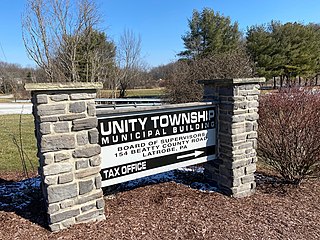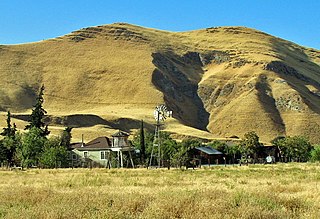
Unity Township is a township in Westmoreland County, Pennsylvania, United States. The population was 21,724 at the 2020 census, a decline of approximately 4% compared to the 2010 census.

Roslyn is a city in Kittitas County, Washington, United States. The population was 950 at the 2020 census. Roslyn is located in the Cascade Mountains, about 80 miles east of Seattle. The town was founded in 1886 as a coal mining company town. During the 20th century, the town gradually transitioned away from coal, and today its economy is primarily based on forestry and tourism. The town was the filming location for The Runner Stumbles, Northern Exposure, and The Man in the High Castle. Many of the town's historical structures have been preserved, and its downtown was added to the National Register of Historic Places in 1978.

Thurber is an unincorporated community in Erath County, Texas, United States, located 75 miles west of Fort Worth. It was, between 1888 and 1921, one of the largest producers of bituminous coal in Texas and the largest company town in the state, with a population of over 10,000. The population of the community is 48 per the 2010 United States Census.

This is a list of sites in Minnesota which are included in the National Register of Historic Places. There are more than 1,700 properties and historic districts listed on the NRHP; each of Minnesota's 87 counties has at least 2 listings. Twenty-two sites are also National Historic Landmarks.

The Black Diamond Mines Regional Preserve is a 6,000-acre (2,400 ha) park located north of Mount Diablo in Contra Costa County, California under the administration of the East Bay Regional Park District (EBRPD). The district acquired the property in 1973. The preserve contains relics of 3 mining towns, former coal and sand mines, and offers guided tours of a former sand mine. The 60 miles (97 km) of trails in the Preserve cross rolling foothill terrain covered with grassland, California oak woodland, California mixed evergreen forest, and chaparral.

Coal Run is an unincorporated community in northeastern Waterford Township, Washington County, Ohio, United States. It has a post office with the ZIP code 45721. It is located along State Route 60 between the villages of Beverly and Lowell. The Muskingum River flows past the community.

Constructed in 1907, the McCreary County Museum is housed in the former Stearns Coal and Lumber Company corporate headquarters in Stearns, Kentucky. The building served as the company's office headquarters in the Southern United States, and maintains the company president's office as an exhibit. The town where the museum is located was called the Stearns Empire of the South, and the museum continues to preserve and display the area's history from the Indian and pioneer times into the town's peak at the height of the coal and lumber industry boom. The exhibits include significant coverage of Appalachian life in McCreary County, including an exhibit on moonshine.

St. Mary's Church and Cemetery is a historic Roman Catholic church building and cemetery in Crompton, a village of West Warwick, Rhode Island.

Woodlawn Cemetery, located in Fairmont, West Virginia, United States, is an example of the rural cemetery. It was laid out by Tell W. Nicolet of the firm of Morris and Knowles of Pittsburgh, PA. It is listed on the National Register of Historic Places as a historic district. Today, the cemetery covers 42 acres (170,000 m2) and has over 15,000 burials.

The Third Addition to Rockville and Old St. Mary's Church and Cemetery is a historic area located in Rockville, Montgomery County, Maryland. This area combines 19th century residential scale buildings with a tree-lined narrow street, country church, weathered headstones, Victorian Gothic railroad station, and a brick cast-iron front commercial structure, to create an atmosphere that evokes the era when the station served as the gateway to Rockville. In addition to Victorian Gothic, architectural styles used in residential buildings include Queen Anne, Georgian, and Colonial Revival. The area was listed on the National Register of Historic Places in 1978.

This is a list of the National Register of Historic Places listings in Fayette County, Ohio.

This is a list of the National Register of Historic Places listings in McDowell County, West Virginia.

This is a list of the National Register of Historic Places listings in Garfield County, Oklahoma.

Black Diamond Cemetery is a cemetery located in Black Diamond, Washington listed on the National Register of Historic Places.
The coal towns, or "coal camps" of Mingo County, West Virginia were situated to exploit the area's rich coal seams. Many of these towns were located in deep ravines that afforded direct access to the coal through the hillsides, allowing mined coal to be dropped or conveyed downhill to railway lines at the valley floor. Many of these encampments were set up as coal towns, and when their mines closed, the towns vanished. Mingo County covers the Williamson Coalfield and a small portion of the Logan Coalfield. Below is partial listing of known coal towns within the Williamson Coalfield and a small portion of the Logan Coalfield. Further listings are available here

The Saint Sava Serbian Orthodox Church is a Serbian Orthodox church in Jackson, California. Built in 1894, the church was the first Serbian Orthodox church in America. Amador County had a large Serbian-American population in the late 1800s due to the California Gold Rush, and the county's Serbs established the St. Sava Church Organization of Amador County in 1886–87; the organization was responsible for purchasing land for and building the church, and the effort was led by Sevastijan Dabović. The church's original design had an Eastern Orthodox influence, complete with an onion dome; while the dome was later replaced by a bell tower, the church's stained glass windows and use of icons still give it a distinctive Eastern Orthodox character. The church has been used for Serbian-American religious and social activities since its opening and is now part of the Serbian Orthodox Eparchy of Western America.

The Gebo Cemetery, in Carbon County, Montana near Fromberg, Montana, was established in 1899 to serve the coal mining town of Gebo, Montana, which had population of 500 to 1,000 in the early 1900s, but was virtually abandoned after the Gebo Mine ceased operation in 1912. It was listed on the National Register of Historic Places in 1993.

Dawson Cemetery is a historic cemetery in Dawson, New Mexico. It was established in 1913. It has been listed on the National Register of Historic Places since April 9, 1992.

The Saint Ann Roman Catholic Church and Rectory is located at 704 Jefferson Street in the City of Hoboken in Hudson County, New Jersey. It was constructed during the tenure of Rev. Michael Gori, who was pastor of the parish from 1921 to 1937. It was added to the National Register of Historic Places on November 24, 2015, for its significance in architecture, religion, and ethnic heritage from 1925 to 1949.




















